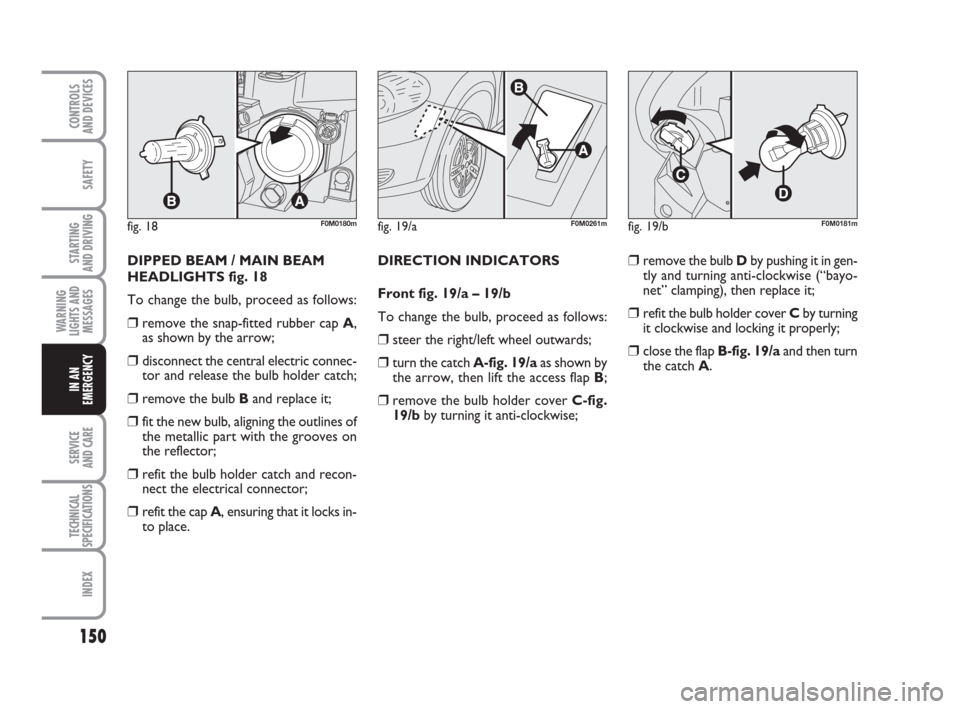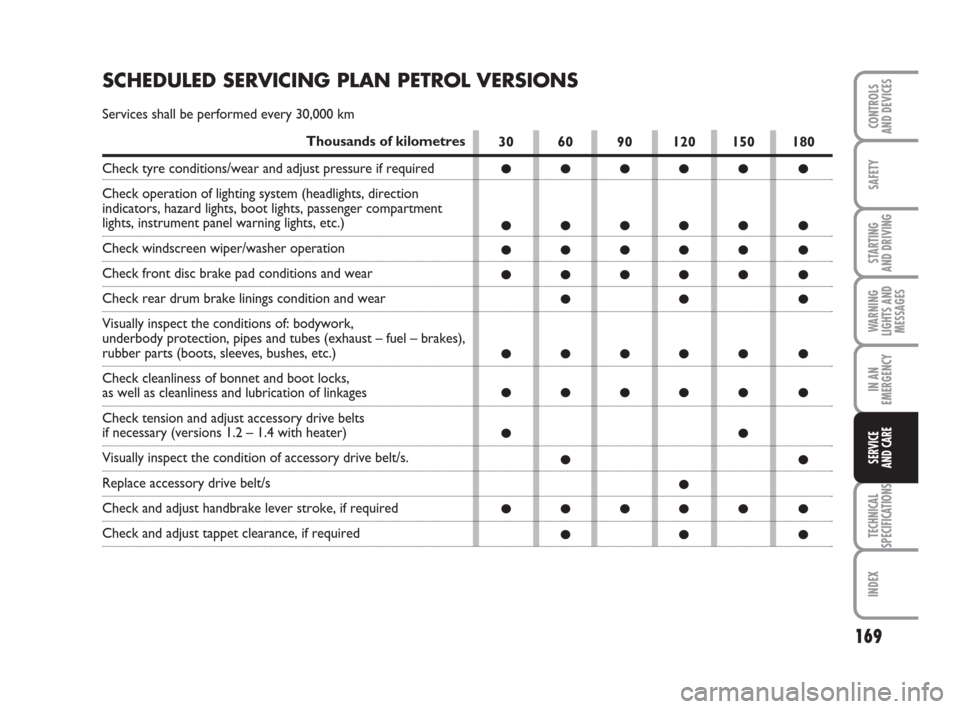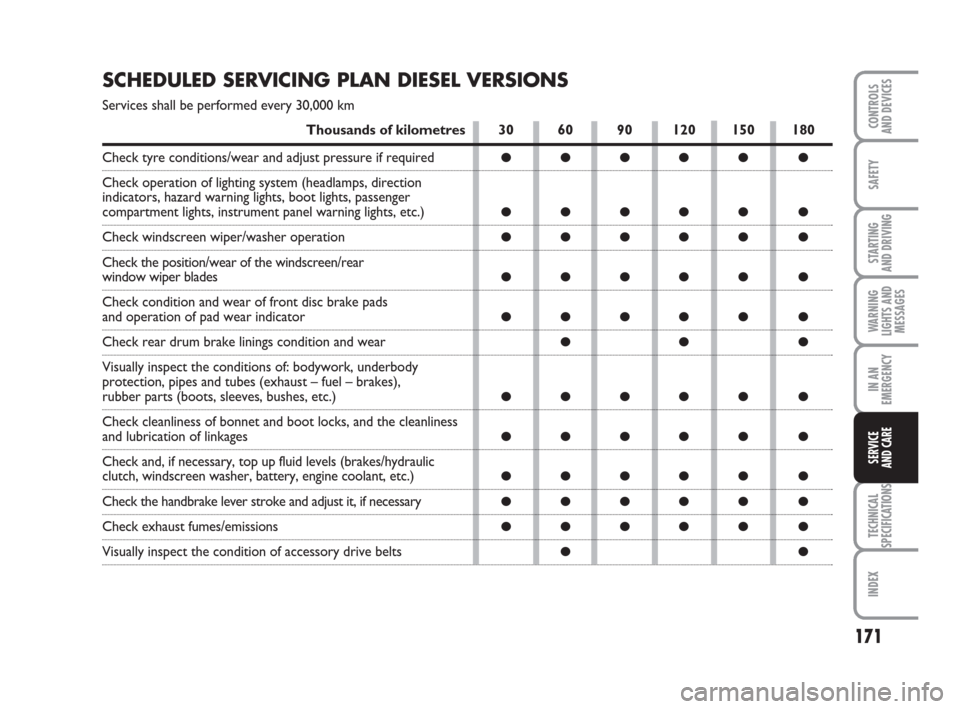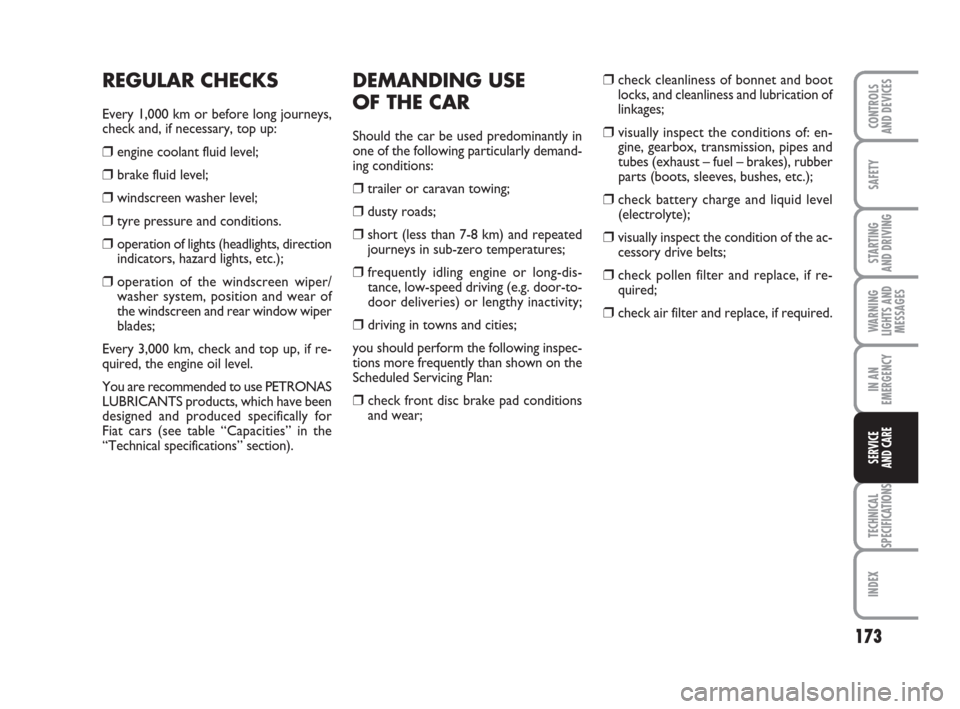Page 134 of 216

133
SAFETY
STARTING
AND DRIVING
IN AN
EMERGENCY
SERVICE
AND CARE
TECHNICAL
SPECIFICATIONS
INDEX
CONTROLS
AND DEVICES
WARNING
LIGHTS AND
MESSAGES
“DUALDRIVE”
ELECTRIC POWER
STEERING ON (green)
The word “CITY” appears on the display
when the “Dualdrive” electric power
steering system is activated by pressing the
relevant control button. Press the button
again to make the “CITY” disappear.
CITY
MAIN BEAM
HEADLIGHTS
(blue)
The light comes on when the main beams
are turned on.
1
FOG LIGHTS
(green)
The light comes on when the front fog
lights are turned on.
5
LEFT-HAND
DIRECTION
INDICATOR
(green – intermittent)
The light (arrow) comes on when the di-
rection indicator control lever is moved
downwards or, together with the right-
hand arrow, when the hazard warning light
button is pressed.
F
RIGHT-HAND
DIRECTION
INDICATOR
(green – intermittent)
The light (arrow) comes on when the di-
rection indicator control lever is moved
upwards or, together with the left-hand
arrow, when the hazard warning light
button is pressed.
D
SIDELIGHTS
AND DIPPED BEAM
HEADLIGHTS (green)
FOLLOW ME HOME
(green)
Sidelights and dipped beam
headlights
The light comes on when the sidelights or
dipped beams are turned on.
Follow Me Home
The light comes on when this device is ac-
tive (see “Follow Me Home” in the “Dash-
board and controls” section).
The display will show a specific message.
3
123-134 ACTUAL 1ed EN 31-08-2010 9:24 Pagina 133
Page 149 of 216
148
SAFETY
STARTING
AND DRIVING
WARNING
LIGHTS AND
MESSAGES
SERVICE
AND CARE
TECHNICAL
SPECIFICATIONS
INDEX
CONTROLS
AND DEVICES
IN AN
EMERGENCY
Bulbs Figure ref. Type Power
Main beams
Dipped beams
Front sidelights
Front fog lights (for versions/markets, where provided)
Front direction indicators
Side direction indicators
Rear direction indicators
Tailights
Brake lights
Third brake light
Reverse lights
Rear fog lights
Number plate lights
Front ceiling light with movable lens
Front ceiling light with spot lights H4
H4
W5W
H3
PY21W
WY5W
P21W
R5W
P21/5W
–
P21W
P21W
W5W
C10W
C10W D
D
A
–
B
A
B
B
B
B
–
–
A
C
C55 W
60 W
5 W
55 W
21 W
5 W
21 W
5 W
5 W
2,3 W
21 W
21 W
5 W
10 W
10 W
135-166 ACTUAL 1ed EN 26-07-2010 16:00 Pagina 148
Page 150 of 216
149
SAFETY
STARTING
AND DRIVING
WARNING
LIGHTS AND
MESSAGES
SERVICE
AND CARE
TECHNICAL
SPECIFICATIONS
INDEX
CONTROLS
AND DEVICES
IN AN
EMERGENCY
CHANGING AN
EXTERIOR BULB
For the type of bulb and relative power
rating, see “Changing a bulb”.
FRONT LIGHT CLUSTERS fig. 16
The front light clusters contain sidelights,
dipped beam, main beam and direction in-
dicator bulbs.
The bulbs are arranged inside the light
cluster as follows:
Asidelights
B
dipped beams/main beams (double light)
Cdirection indicatorsSIDELIGHTS fig. 17
To change the bulb, proceed as follows:
❒remove the snap-fitted rubber cap A,
as shown by the arrow;
❒press in tabs Band remove the bulb
holder;
❒remove the bulb Cand replace it;
❒refit the bulb holder and refit the cap
A, ensuring that it locks into place.
fig. 16F0M0178mfig. 17F0M0179m
135-166 ACTUAL 1ed EN 26-07-2010 16:00 Pagina 149
Page 151 of 216

150
SAFETY
STARTING
AND DRIVING
WARNING
LIGHTS AND
MESSAGES
SERVICE
AND CARE
TECHNICAL
SPECIFICATIONS
INDEX
CONTROLS
AND DEVICES
IN AN
EMERGENCY
DIPPED BEAM / MAIN BEAM
HEADLIGHTS fig. 18
To change the bulb, proceed as follows:
❒remove the snap-fitted rubber cap A,
as shown by the arrow;
❒disconnect the central electric connec-
tor and release the bulb holder catch;
❒remove the bulb Band replace it;
❒fit the new bulb, aligning the outlines of
the metallic part with the grooves on
the reflector;
❒refit the bulb holder catch and recon-
nect the electrical connector;
❒refit the cap A, ensuring that it locks in-
to place.DIRECTION INDICATORS
Front fig. 19/a – 19/b
To change the bulb, proceed as follows:
❒steer the right/left wheel outwards;
❒turn the catch A-fig. 19/aas shown by
the arrow, then lift the access flap B;
❒remove the bulb holder cover C-fig.
19/bby turning it anti-clockwise;
❒remove the bulb Dby pushing it in gen-
tly and turning anti-clockwise (“bayo-
net” clamping), then replace it;
❒refit the bulb holder cover Cby turning
it clockwise and locking it properly;
❒close the flap B-fig. 19/aand then turn
the catch A.
fig. 18F0M0180mfig. 19/bF0M0181mfig. 19/aF0M0261m
135-166 ACTUAL 1ed EN 26-07-2010 16:00 Pagina 150
Page 152 of 216

151
SAFETY
STARTING
AND DRIVING
WARNING
LIGHTS AND
MESSAGES
SERVICE
AND CARE
TECHNICAL
SPECIFICATIONS
INDEX
CONTROLS
AND DEVICES
IN AN
EMERGENCY
Sidelights fig. 20
To change the bulb, proceed as follows:
❒slide the lens Ato press in the inter-
nal catch B, then pull the unit outwards;
❒turn the bulb holder Canti-clockwise,
remove the snap-fitted bulb Dand re-
place it;
❒refit the bulb holder Cinto the lens by
turning it clockwise;
❒refit the unit making sure the internal
catch Bclicks into place.FRONT FOG LIGHTS
(for versions/markets, where provided)
Contact a Fiat Dealership to have bulbs
for the front fog lights A-fig. 21replaced.
REAR LIGHT CLUSTERS
fig. 22-23
The rear light clusters contain taillight,
brake light and direction indicator bulbs.
The bulbs are arranged inside the light
cluster as follows:
Bdirection indicators
Ctaillights
Dtaillights/brake light (double light).
fig. 20F0M0182m
fig. 22F0M0184m
fig. 21F0M0223m
135-166 ACTUAL 1ed EN 26-07-2010 16:00 Pagina 151
Page 170 of 216

169
SAFETY
STARTING
AND DRIVING
WARNING
LIGHTS AND
MESSAGES
IN AN
EMERGENCY
TECHNICAL
SPECIFICATIONS
INDEX
CONTROLS
AND DEVICES
SERVICE
AND CARE
30 60 90 120 150 180
●●●●● ●
●●●●● ●
●●●●● ●
●●●●● ●
●● ●
●●●●● ●
●●●●● ●
●●
●●
●
●●●●● ●
●● ●
SCHEDULED SERVICING PLAN PETROL VERSIONS
Services shall be performed every 30,000 km
Thousands of kilometres
Check tyre conditions/wear and adjust pressure if required
Check operation of lighting system (headlights, direction
indicators, hazard lights, boot lights, passenger compartment
lights, instrument panel warning lights, etc.)
Check windscreen wiper/washer operation
Check front disc brake pad conditions and wear
Check rear drum brake linings condition and wear
Visually inspect the conditions of: bodywork,
underbody protection, pipes and tubes (exhaust – fuel – brakes),
rubber parts (boots, sleeves, bushes, etc.)
Check cleanliness of bonnet and boot locks,
as well as cleanliness and lubrication of linkages
Check tension and adjust accessory drive belts
if necessary (versions 1.2 – 1.4 with heater)
Visually inspect the condition of accessory drive belt/s.
Replace accessory drive belt/s
Check and adjust handbrake lever stroke, if required
Check and adjust tappet clearance, if required
167-186 ACTUAL 1ed EN 27-07-2010 10:30 Pagina 169
Page 172 of 216

171
SAFETY
STARTING
AND DRIVING
WARNING
LIGHTS AND
MESSAGES
IN AN
EMERGENCY
TECHNICAL
SPECIFICATIONS
INDEX
CONTROLS
AND DEVICES
SERVICE
AND CARE
SCHEDULED SERVICING PLAN DIESEL VERSIONS
Services shall be performed every 30,000 km
30 60 90 120 150 180
●●●●● ●
●●●●● ●
●●●●● ●
●●●●● ●
●●●●● ●
●● ●
●●●●● ●
●●●●● ●
●●●●● ●
●●●●● ●
●●●●● ●
●●
Thousands of kilometres
Check tyre conditions/wear and adjust pressure if required
Check operation of lighting system (headlamps, direction
indicators, hazard warning lights, boot lights, passenger
compartment lights, instrument panel warning lights, etc.)
Check windscreen wiper/washer operation
Check the position/wear of the windscreen/rear
window wiper blades
Check condition and wear of front disc brake pads
and operation of pad wear indicator
Check rear drum brake linings condition and wear
Visually inspect the conditions of: bodywork, underbody
protection, pipes and tubes (exhaust – fuel – brakes),
rubber parts (boots, sleeves, bushes, etc.)
Check cleanliness of bonnet and boot locks, and the cleanliness
and lubrication of linkages
Check and, if necessary, top up fluid levels (brakes/hydraulic
clutch, windscreen washer, battery, engine coolant, etc.)
Check the handbrake lever stroke and adjust it, if necessary
Check exhaust fumes/emissions
Visually inspect the condition of accessory drive belts
167-186 ACTUAL 1ed EN 27-07-2010 10:30 Pagina 171
Page 174 of 216

173
SAFETY
STARTING
AND DRIVING
WARNING
LIGHTS AND
MESSAGES
IN AN
EMERGENCY
TECHNICAL
SPECIFICATIONS
INDEX
CONTROLS
AND DEVICES
SERVICE
AND CARE
DEMANDING USE
OF THE CAR
Should the car be used predominantly in
one of the following particularly demand-
ing conditions:
❒trailer or caravan towing;
❒dusty roads;
❒short (less than 7-8 km) and repeated
journeys in sub-zero temperatures;
❒ frequently idling engine or long-dis-
tance, low-speed driving (e.g. door-to-
door deliveries) or lengthy inactivity;
❒ driving in towns and cities;
you should perform the following inspec-
tions more frequently than shown on the
Scheduled Servicing Plan:
❒ check front disc brake pad conditions
and wear;
❒check cleanliness of bonnet and boot
locks, and cleanliness and lubrication of
linkages;
❒ visually inspect the conditions of: en-
gine, gearbox, transmission, pipes and
tubes (exhaust – fuel – brakes), rubber
parts (boots, sleeves, bushes, etc.);
❒check battery charge and liquid level
(electrolyte);
❒visually inspect the condition of the ac-
cessory drive belts;
❒check pollen filter and replace, if re-
quired;
❒check air filter and replace, if required.
REGULAR CHECKS
Every 1,000 km or before long journeys,
check and, if necessary, top up:
❒engine coolant fluid level;
❒brake fluid level;
❒windscreen washer level;
❒tyre pressure and conditions.
❒operation of lights (headlights, direction
indicators, hazard lights, etc.);
❒operation of the windscreen wiper/
washer system, position and wear of
the windscreen and rear window wiper
blades;
Every 3,000 km, check and top up, if re-
quired, the engine oil level.
You are recommended to use PETRONAS
LUBRICANTS products, which have been
designed and produced specifically for
Fiat cars (see table “Capacities” in the
“Technical specifications” section).
167-186 ACTUAL 1ed EN 27-07-2010 10:30 Pagina 173